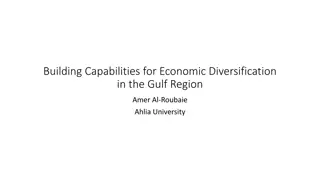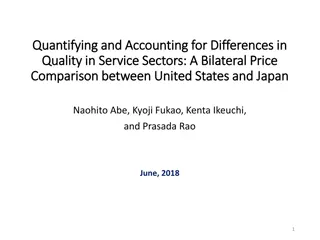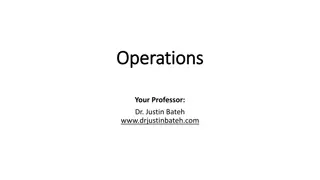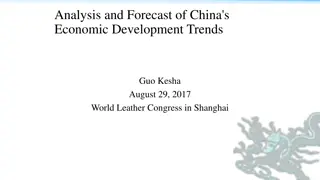Understanding the Role of Productivity in Economic Growth
The real economy in the long run is influenced by production and growth. Productivity is key to determining living standards in nations worldwide. This article explores the significance of productivity, its role, and determinants in shaping the economy and living standards. Economic growth around the world varies, with productivity playing a crucial role in enhancing the standard of living.
Download Presentation

Please find below an Image/Link to download the presentation.
The content on the website is provided AS IS for your information and personal use only. It may not be sold, licensed, or shared on other websites without obtaining consent from the author. Download presentation by click this link. If you encounter any issues during the download, it is possible that the publisher has removed the file from their server.
E N D
Presentation Transcript
9 THE REAL ECONOMY IN THE LONG RUN
Chapter (5) Production and Growth (Chapter 25 in the Book)
Production and Growth A country s standard of living depends on its ability to produce goods and services. Within a country there are large changes in the standard of living over time. In the United States over the past century, average income as measured by real GDP per person has grown by about 2 percent per year.
Definitions Productivity refers to the amount of goods and services produced for each hour of a worker s time. A nation s standard of living is determined by the productivity of its workers.
Economic Growth Living standards, as measured by real GDP per person, vary significantly among nations.
Real GDP per Capita GDP per capita: is the product of output per worker and the share of the total population that is working WHERE: o Y = real GDP o N = number of people employed o POP = population Consumption per person depends on: o How much each worker produces. o The share of people working.
Economic Growth around the world The poorest countries have average levels of income that have not been seen in the United States for many decades. Annual growth rates that seem small become large when compounded for many years. Compounding refers to the accumulation of a growth rate over a period of time.
Productivity: Its Role and Determinants Productivity plays a key role in determining living standards for all nations in the world.
Why Productivity Is So Important? 1. Productivity refers to the amount of goods and services that a worker can produce from each hour of work. 2. To understand the large differences in living standards across countries, we must focus on the production of goods and services.
How Productivity is Determined The inputs used to produce goods and services are called the factors of production. The factors of production directly determine productivity.
How Productivity is Determined The Factors of Production are: o Physical capital o Human capital o Natural resources o Technological knowledge
Physical Capital 1. Physical Capital is a produced factor of production: It is an input into the production process that in the past was an output from the production process. 2. Physical Capital is the stock of equipment and structures that are used to produce goods and services: Tools used to build or repair automobiles. Tools used to build furniture. Office buildings, schools, etc.
Human Capital o Human Capital is the economist s term for the knowledge and skills that workers acquire through education, training, and experience o Like physical capital, human capital raises a nation s ability to produce goods and services.
Natural Resources o Natural Resources are inputs used in production that are provided by nature, such as land, rivers, and mineral deposits. Renewable resources include trees and forests. Nonrenewable resources include petroleum and coal. o Natural Resources can be important but are not necessary for an economy to be highly productive in producing goods and services.
Technological Knowledge o Technological Knowledge is society s understanding of the best ways to produce goods and services. o Human capitalrefers to the resources expended transmitting this understanding to the labor force.
The Production Function Economists often use a production function to describe the relationship between the quantity of inputs used in production and the quantity of output from production.
The Production Function Y = A F(L, K, H, N) o Y = quantity of output o A = available production technology o L = quantity of labor o K = quantity of physical capital o H = quantity of human capital o N = quantity of natural resources o F( ) is a function that shows how the inputs are combined. If A increases, the economy produces more output from any given combination of input
Economic Growth and Public Policy Governments can do many things to raise productivity and living standards. Government Policies That Raise Productivity and Living Standards: o Encourage saving and investment. o Encourage investment from abroad o Encourage education and training. o Establish secure property rights and maintain political stability. o Promote free trade. o Promote research and development.
The Importance of Saving and Investment One way to raise future productivity is to invest more current resources in the production of capital.
Diminishing Returns and the Catch-Up Effect As the stock of capital rises, the extra output produced from an additional unit of capital falls; this property is called diminishing returns. Because of diminishing returns, an increase in the saving rate leads to higher growth only for a while. In the long run, the higher saving rate leads to a higher level of productivity and income, but not to higher growth in these areas.
Example Number of Machines Hours Worked per Week Output per Hour Worked Output per Week 0 1 2 3 16,000 32,000 40,000 40,000 80 80 80 80 200 400 500 500 . More capital increases output per hour. BUT there are limits to increase the productivity by adding capital (Diminishing returns to capital)
Example Number of Machines Hours Worked per Week Output per Hour Worked Output per Week 0 1 2 3 16,000 32,000 40,000 40,000 80 80 80 80 200 400 500 500 . So when workers already have large Q of capital (Machines), giving them additional unit (Machine) will only increase their productivity at SLOWER RATE. In the above table: The productivity increase by 100% in machine 1 Then only 25% in machine 2 Then 0% in machine 3 We can Say that: Output is increasing at a decreasing rate
Diminishing Returns and the Catch-Up Effect The catch-up effect refers to the property whereby countries that start off poor tend to grow more rapidly than countries that start off rich.
Investment from Abroad Governments can increase capital accumulation and long-term economic growth by encouraging investment from foreign sources.
Investment from Abroad Investment from abroad takes several forms: o Foreign Direct Investment: Capital investment owned and operated by a foreign entity. o Foreign Portfolio Investment: Investments financed with foreign money but operated by domestic residents.
Education For a country s long-run growth, education is at least as important as investment in physical capital. o In the United States, each year of schooling raises a person s wage, on average, by about 10 percent. o Thus, one way the government can enhance the standard of living is to provide schools and encourage the population to take advantage of them.
Education An educated person might generate new ideas about how best to produce goods and services, which in turn, might enter society s pool of knowledge and provide an external benefit to others. One problem facing some poor countries is the brain drain. brain drain is the emigration of many of the most highly educated workers to rich countries.
Property Rights and Political Stability Property rights refer to the ability of people to exercise authority over the resources they own. o An economy-wide respect for property rights is an important prerequisite for the price system to work. o It is necessary for investors to feel that their investments are secure.
Free Trade Trade is, in some ways, a type of technology. A country that eliminates trade restrictions will experience the same kind of economic growth that would occur after a major technological advance. Some countries engage in . . . o . . . inward-orientated trade policies, avoiding interaction with other countries. o . . . outward-orientated trade policies, encouraging interaction with other countries.
Research and Development The advance of technological knowledge has led to higher standards of living. o Most technological advance comes from private research by firms and individual inventors. o Government can encourage the development of new technologies through research grants, tax breaks, and the patent system.
Population Growth Economists and other social scientists have long debated how population growth affects a society Population growth interacts with other factors of production: o Stretching natural resources o Diluting the capital stock o Promoting technological progress
Summary Economic prosperity, as measured by real GDP per person, varies substantially around the world. The average income of the world s richest countries is more than ten times that in the world s poorest countries. The standard of living in an economy depends on the economy s ability to produce goods and services.
Summary Productivity depends on the amounts of physical capital, human capital, natural resources, and technological knowledge available to workers. Government policies can influence the economy s growth rate in many different ways.
Summary The accumulation of capital is subject to diminishing returns. Because of diminishing returns, higher saving leads to a higher growth for a period of time, but growth will eventually slow down. Also because of diminishing returns, the return to capital is especially high in poor countries.























